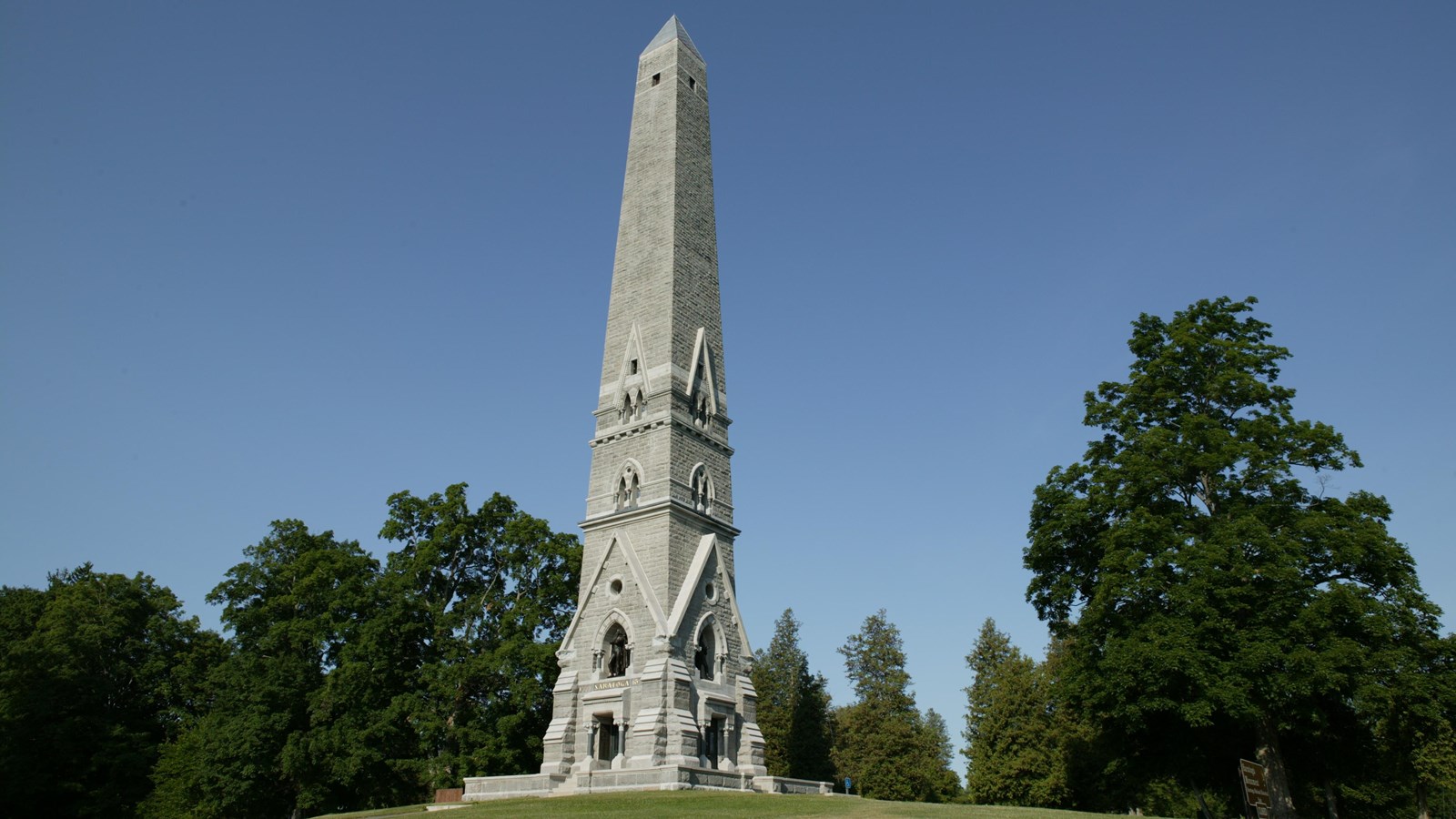Last updated: September 11, 2025
Place
Saratoga Monument

NPS
Benches/Seating, Bicycle - Rack, Cellular Signal, First Aid Kit Available, Historical/Interpretive Information/Exhibits, Information Kiosk/Bulletin Board, Parking - Auto, Parking - Bus/RV, Restroom - Seasonal, Scenic View/Photo Spot, Trailhead, Water - Drinking/Potable
Hours/Season
Visit the operating hours page for schedule updates.
Commemorating Burgoyne's surrender to Gates, this 155-foot stone obelisk stands where Burgoyne's camp entrenched during the campaign's final days.
"Saratoga Monument, like Bunker Hill, Bennington, Oriskany, and Washington monuments are founded on and reared by sentiment...The sentiment that wrought this miracle in stone and bronze was pride in the deeds of our fathers and reverence for their characters."
- John Henry Brandow, 1901
A Miracle in Stone and Bronze
The “deeds” of which John Henry Brandow spoke were those of a young America winning a stunning Revolutionary War victory over a world-class invading British army. Battles fought near Stillwater led to the British surrender at Saratoga on October 17, 1777. Known as the “Turning Point of America’s Revolutionary War,” the victory at Saratoga boosted American patriot morale and brought vital international aid. This paved the way to winning American independence and creating a nation grounded in the concepts of liberty and freedom for all.
“[R]everence for their characters” is captured in life-size sculptures of key American leaders of 1777. General Philip Schuyler faces east toward his Saratoga estate, burned by the British but rebuilt the following month. To the west, Colonel Daniel Morgan faces the positions his corps took to help surround the British. In the northern niche, General Horatio Gates faces toward the route of British invasion from Canada. The southern niche remains empty, signifying General Benedict Arnold’s heroism in 1777 overshadowed by his later treachery.
Creating Saratoga Monument
“The battles…of Saratoga and surrender of Lt. General John Burgoyne, on the 17th of October, 1777 formed a niche in the temple of Liberty, which patriotism will one day fill with an appropriate monument.”
- Saratoga Monument Association meeting, 1856
Inspired by these patriotic words, a group of local residents organized the Saratoga Monument Association in 1856. Halted by the cataclysm of the Civil War, the group was re-energized in 1872, intent on commemorating the centennial of Burgoyne’s surrender in October 1877. They chose Jared C. Markham as architect and the Booth Brothers of New York City as builders, and laid the cornerstone on the 100th anniversary of the American victory. Attempts to raise money and public support began in earnest, yet proved to be a difficult process. Only $2,300 was raised from private donations; the greater part of moneys used for the Monument’s construction came from the Federal government ($95,000) and New York State ($10,000). A debt of $4,500 remained in 1895 when the Monument was transferred to the state of New York.
-
October 17, 1877: cornerstone laid
-
November 3, 1882: capstone placed
-
August 1887: bronze statues completed
-
August 1895: financial realities required transfer to New York State (NYS)
-
October 1897: initial landscaping completed
-
October 17, 1912: official dedication upon the 135th anniversary of Burgoyne’s surrender
-
May 1980: Monument transferred to the National Park Service (NPS)
Features of Saratoga Monument
The Monument, which features Gothic and Egyptian styled elements, is a rock-faced granite obelisk situated on a high bluff upon the grounds of Burgoyne’s last camp and overlooks the scenic Hudson Valley.
Within the Monument are 188 steps that connect five levels and a viewing platform at the top. Upon the walls of the first two levels are 16 bronze bas relief plaques depicting dramatized scenes of the American Revolution. Other interior decorative items include ornamental ceramic tile, brass moldings, stained glass and terracotta cornices.
The cornerstone contains a U.S. flag, a 1777 silver coin bearing the image of King George III, an 1877 U.S. silver half dollar, a memorial to the opening of the New York and Canada Railway, Bennington Battle Monument Association documents and 21 newspapers.
Preserving Saratoga Monument
Since its early days the Monument has been plagued by water infiltration causing deterioration of interior stonework and metal elements. Repairs over the years include:
- 1912: comprehensive re-pointing of stonework
- 1955: interior walls and metal stairway repaired
- 1964: rehabilitation of masonry, windows, stairs, and lightning protection
- 1970: closed by NYS due to safety concerns
- 1981: NPS repaired masonry, flashing and lightning protection
- 1987: closed due to safety concerns—engineering studies begin
- 1999: $3 million comprehensive rehabilitation begun by NPS
- 2002: Monument reopened to public visitation
- 2005: new entrance and parking area constructed
- 2017: re-pointing of first 60 feet of stonework (HOPE youth group)
- 2018: repainting of stairs and update to emergency lighting
The preservation and maintenance of Saratoga Monument has been entrusted to the National Park Service. Although the major work of rehabilitating the Monument has been completed, constant monitoring and evaluation are important functions to ensure that the site will be available for future generations.
